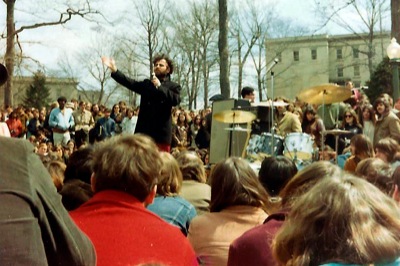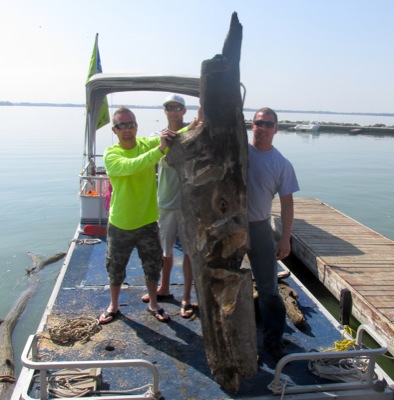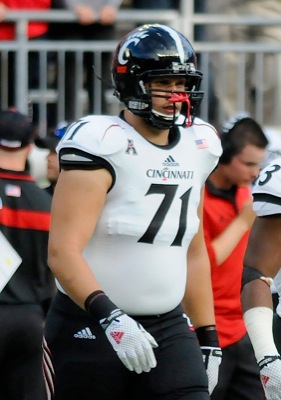Monday, May 4th, 2015
Kent State killings remembered
Local residents reflect on dark day in nation's history during Vietnam War
By David Giesige

Submitted Photo
Political activist Jerry Rubin speaks to Kent State students at an anti-war rally April 30, 1970. This rally and other anti-war protests led then- Gov. James A. Rhodes to send the National Guard to the campus. On May 4, 1970, guardsmen opened fire on a crowd of students, killing four and wounding nine. Area residents who have connections to the event are still affected by it today.
May 4, 1970, was a beautiful spring day and Kent State University students were going about their daily lives.
Final exams were approaching, and after a long weekend of war protests, students were ready to hit the books, take tests and head home.
What happened 45 years ago today, though, has gone down in history as one of America's most seminal moments. National Guardsmen, who were called in because of the protests against the invasion of Cambodia, opened fire on a mass of unarmed students, killing four and wounding nine.
The Kent State shootings had an immediate impact on the school, the students and the country as people mourned the loss of life and began to question the motives of those in charge.
The events of that day still haunt alumni such as Celina High School English teacher Chuck Smith, who was a Kent State freshman at the time.
According to Smith, describing the events of the horrific day and those that led up to it is like "going down a rabbit hole." It's a complicated story, he said.
"The Thursday before - and it's interesting this year because the dates match up; May 4 was a Monday then and it's a Monday now - there was an anti-war rally on campus," Smith said.
Political activist Jerry Rubin spoke to students at the April 30 rally about the futility of the Vietnam war. Smith, who attended the rally, said at the time anti-war sentiment was prevalent all over the campus and the country.
He, too, was against the war, he said.
"I was absolutely not in favor of the war. It was a pointless war with no real objective. We were propping up a government that would fall as soon as we left. It was a waste of American lives; a lot of people in my generation died in Vietnam," Smith said.
Jan Fiser, a retired New Bremen High School teacher, also was at Kent at the time of the shooting. It was the end of her sophomore year, and like Smith, she remembered the unrest on campus after it was revealed the government had secretly been bombing Cambodia.
"I think it's important that people realize - and not a lot of people know this - that the people protesting on campus were not all Kent State students. People had come from all over to protest," Fiser said.
While she was not in favor of the war, she did not support the students who caused destruction throughout the weekend leading up to May 4, she said.
"It wasn't me to cause destruction, that's not who I was and that's not who I am," Fiser said.
Smith and Fiser said May 1, 1970, was relatively uneventful. Concerns about rambunctious students prompted bar owners in the village of Kent to close. However, their action had the opposite effect, Smith said.
"So they closed the bars and what did that do? It flooded the streets with drunk college kids using politics as a vehicle to act out. A few windows were broken, which put law enforcement on alert," he recalled.
Violence escalated the next day. The night before the fatal shootings, a handful of students set fire to Kent State's ROTC buildings.
"Those buildings were at the center of the campus; it drew a huge crowd. People were chopping the fire department's hoses to prevent them from extinguishing the flames," Smith said.
The violence and vandalism prompted then-Gov. James A. Rhodes to send the National Guard to the campus to quell the protests and riots. The action did not go over well with the students.
"It just didn't make any sense to me. Why would you bring in the military to quell protests against the military?" Fiser asked.
Smith said the guardsmen were not prepared.
"The National Guard they sent had just left a violent protest in Cleveland. These guys weren't much older than the students and were not properly trained to handle a situation like the one at Kent," he said.
To support his claim, he spoke about an incident a day before the shooting when guardsmen had broken up a peaceful rally with tear gas and bayonets. Smith, who had attended the May 3 rally, watched students get beaten and clubbed before he was chased into the school library by a guardsmen with an M16 rifle, he said.
Smith said the guardsmen had been sympathetic to the students prior to May 4.
"A big reason a lot of the kids in the National Guard joined was to avoid going to Vietnam. So there were times when they would be talking to students and commiserating about the war," he said.
Those same guardsmen were on Taylor Hill this afternoon opening fire on thousands of students, Smith said.
"I was in class at the time," Fiser said. "I remember a professor coming in and telling the class what happened. I can never give enough praise to the professors for how they handled things that day."
The shooting literally hit close to home for Fiser. Her dorm was not far from Taylor Hill and her roommate heard the gunshots through an open window.
For Smith, it was more personal. A girlfriend of a friend on his dorm floor was one of the four shot and killed.
"It was such an unnecessary tragedy. It was sad and pointless and it ruined a lot of peoples' lives. I want to live in a country where you disagree with the government without getting shot, and that never should have happened," he said.
Despite the outcome, Smith said he harbors no ill-will toward the guardsmen.
"My negative thoughts are aimed more toward the governor and the others who were in charge. It's a leadership issue. Those kids were not ready or properly trained for what they were sent in for," Smith said.
Fiser agreed.
"That sort of thing should never have happened on an American campus," she said. "But I have a more encompassing perspective now. I have a brother-in-law who was on the riot squad at Ohio State at the time and another who flew a helicopter in Cambodia. Those guardsmen were putting their lives in danger, too, so I try to look at it from all sides."
Fiser said students the following fall just wanted things to go back to normal and there wasn't as much unrest. Smith remembered campus officials making special efforts to empower students and give them more say in school operations.
Kent State officials today take strides to remind current students about what happened 45 years ago.
Zoe Kriegel, Celina, a junior at Kent State, said she was drawn to the university, in part, by the role it played in U.S. history.
"I felt a sense of connection with the university," she said. "I wanted to be a part of something that had such an impact."
One of Kriegel's favorite places on campus is the May 4 memorial. Plaques commemorate the location of the shootings, a new museum recently opened in Taylor Hall and professors give special lectures on what happened that day.
"The university has evolved since then but they didn't simply cover up what occurred. Each student's last moments aren't forgotten," she said.
Kriegel said the atmosphere gives her a sense of pride.
"I feel proud to know that there is a culture of making important issues and viewpoints known. I connect more with the fact that a group of people had something important to say and they came together to say it," she added.
Fiser said she is proud of how Kent State handled the shootings and believes it's unfortunate the university had to deal with the fallout.
"It was a good school given a bad name," she said. "There was more destruction going on at places like OSU but we are the ones remembered, and rightly so."




